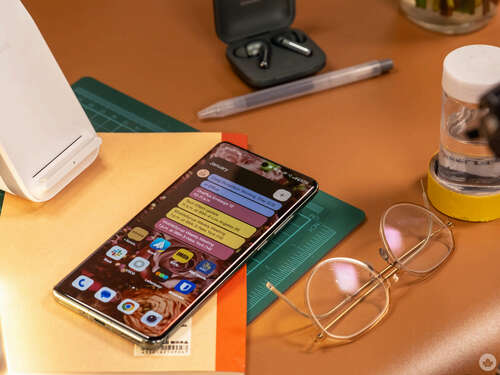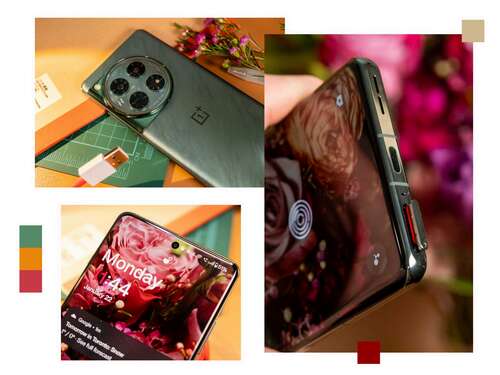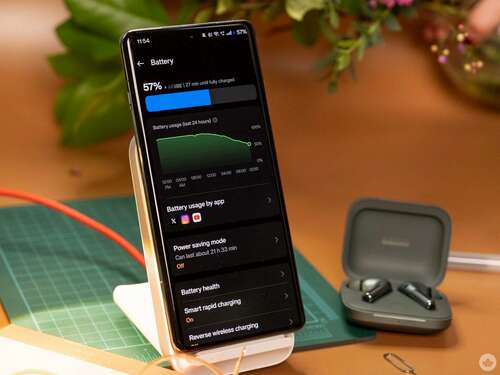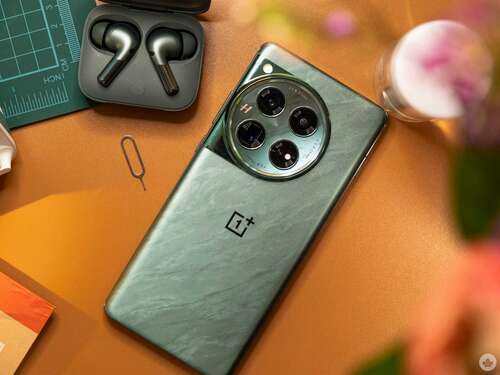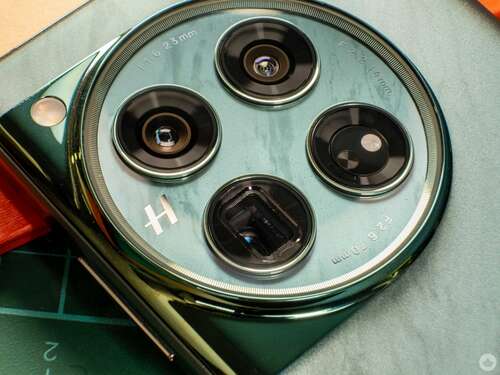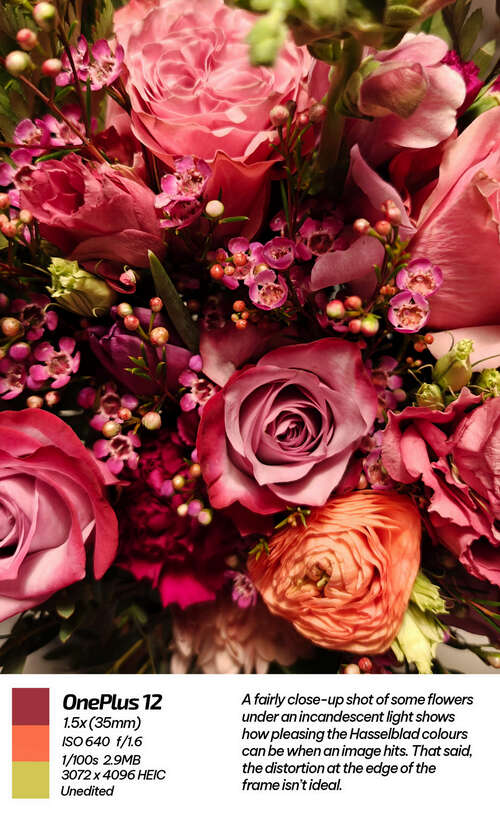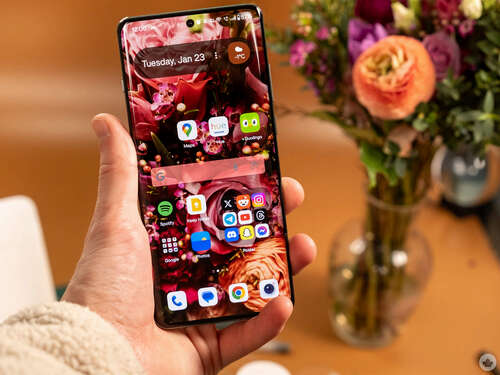The OnePlus 12 is an amazing smartphone. The camera takes great images, the battery is long-lasting, and the materials are top-notch, but it’s the same old story with OnePlus. I constantly have to turn it on and off to relegate minor bugs that detract from the overall experience.
This doesn’t make the phone terrible. On the contrary, it’s rather good, but compared to other devices, it can sometimes be annoying.
That being said, OnePlus fans will be happy about the return of the wireless charger… even if it means making it the heaviest OnePlus flagship phone in a long time.
XL design
The phone looks like a slightly larger OnePlus 11 to my eyes, but the battery is a larger 5,400 mAh instead of 5,000, and there’s a wireless charging pad, so not only is it larger, but it’s slightly heavier, too. Over time, I’ve gotten used to it, but as the OnePlus and others have gotten larger over the years, I can definitely feel the strain on my pinky finger.
I’d be more forgiving if the OnePlus 12 utilized Qi2 magnetic charging, but instead, OnePlus has opted for 50-watt super-fast wireless charging if you buy a OnePlus AIRVOOC wireless charger. I couldn’t test out the latest version of the charger, but the one launched alongside the OnePlus 9 Pro still works as advertised here. That said, 50-watt wireless charging isn’t a huge game changer since I use wireless charging to power up overnight or when my phone is at my desk. In both situations, I usually have around 3-9 hours for my phone to power up slowly.
Therefore, as usual with OnePlus phones, I rarely even charge overnight anymore since I feel so comfortable topping it up with the 80-watt SUPERVOOC fast charging in the morning or before bed. Plugged in, it takes under 30 minutes to go from 10 percent to 100. The best part about the phone is that it comes with this excellent 80-watt charger in the box. The fact that the charger has a USB-A port is still a bit annoying as the world moves to USB-C everywhere, but it’s not the end of the world.
Overall, I’m happy with the battery life on the OnePlus 12, but I’ve also been keeping the screen set to 1080p and the refresh rate set to auto since I wanted to get the most battery life each day.
Speaking of the screen, this panel has a peak brightness of 4,500 nits, which is incredibly bright on paper, but in practice, it doesn’t feel twice as bright as the 2,000-nit display on my iPhone or the 1,500 nits on the OnePlus 11. That said, outdoors may unlock the display’s full potential since I have no complaints there. That said, the peak brightness is only for small parts of the display when viewing HDR content, so the extremely bright 4,500 nit rating feels slightly overblown when the phone only feels marginally brighter in practice than its predecessor.
The rear panel on my unit has a moulted green colour called ‘Flowey Emerald’ that’s meant to emulate the flowing patterns of the Dart River in the Southern Alps. While the back pattern is interesting, tying it to the ice-blue Dart River feels strange since it looks more like a fake green marble pattern. At the end of the day, it’s a subtle shift on the standard emerald colours other OnePlus phones have used, but to me, it’s a little dull and I would have loved OnePlus to offer more colours this year.
Overall, the design and battery are very ‘large and in charge’ for better or worse. For those who like smaller phones, the OnePlus 12 is likely too big, but fans of huge phones like the Galaxy Ultra series might be tempted by the OnePlus 12’s more throwback design. While Samsung might be moving to flat displays, OnePlus still has curved edges if that’s your preference. When testing the phone, I didn’t encounter too many miss-taps because of the edges, but on a large phone like this, I rarely tried to do tasks one-handed.
A camera upgrade to care about
I’m happy to report that the OnePlus 12 slightly improves on the already fantastic camera system from the OnePlus Open. The company was one of the first to use Sony’s top-end LYTA sensors in its main lens. This LYTA-808 sensor uses stacked technology to capture more colour depth and light, resulting in the potential for really pleasing images.
That said, these improvements only apply to the main lens, so like the Open, the zoom and ultra-wide cameras feel a step behind. In most cases, they still take great images, but I’m always pushing for more unification among various camera lenses on one phone.
While the primary lens features Sony’s top-of-the-line sensor technology, there are larger and better LYTA sensors in the ‘900 series’ that use 1-inch sensors featured on the Oppo Find X7. That said, 1-inch sensors are rare in North America, and the LYTA-808 competes squarely with Samsung’s sensor in the S24 Ultra and the latest iPhone 15 series.
In actuality, the lens is fantastic for photography. With adequate lighting, it takes sharp photos with the softness of a real camera, and there’s a ton of detail. OnePlus is still partnered with Hasselblad, which gives the camera an edge in colour reproduction. It’s not always perfect, but sometimes there are really nice orange hues that give the images a defining look.
In artificial lighting, OnePlus oversharpens slightly, but the photos still look nice. In low light, all of the phone’s lenses perform admirably, and I was surprised with how well they held up as long as I held steady. If you introduce movement, the phone seems to use more processing to brighten the image, leading to weird, smoothed-out images that sometimes look vaguely AI. The phone’s processing also sometimes weirdly highlights people and pets, which can ruin the shot by making it look fake, in an attempt to make it brighter.
This is a recurring trend with smartphone photography that I hope gets ironed out in the next few years. In an effort to make every single shot look good, computational photography algorithms now edit your photos more than ever. On a bright photo, this is rarely noticeable because the algorithm doesn’t need to work very hard to brighten things. However, in a dark photo, it often becomes apparent that extra smoothing was applied to my face or I was brightened. Hopefully, photo algorithms can find a sweet spot soon that helps dark photos look more natural.
Overall, I was happy with all the lenses and the camera features packed inside, like XPan mode and the nice portrait blur effects that emulate vintage Hasselblad lenses. You can also set the default focal length to 35mm, which can help smartphone cameras punch above their weight class by giving a tighter image frame with the potential for a slightly more blur when you have a distance between the foreground/background and the subject.
Running out of Oxygen
While a few bugs can be attributed to new phone jitters, I find it all too common with OnePlus devices, and the 12 has been no different. In the two weeks I’ve used the phone, I’ve had to reset the device every second day at the least, and on a few days, I’ve needed to reset it more than once.
The most pressing issue is that sometimes my messages just happen to come hours late. It’s hard to notice these since both parties just assume the other is ignoring them, but when on more than one occasion, I’ve gotten messages that should have been sent at the same time, minutes or even hours apart.
Beyond that, the Google search bar widget on the home screen keeps going into ‘initialization’ mode, resulting in the app restarting every time I touch the search bar. For one dreamily long minute, my clock was stuck at 12:08 for a real-world time of 28 minutes. Again, none of these are phone-breaking bugs, but combined with previous OnePlus experiences, it’s worth pointing out.
It’s also a bit disappointing that somehow Google and Samsung are getting the newest Android AI ‘Circle to Search’ feature while OnePlus is left behind. Instead, the company seems to be adding new features with gaming in mind, like its ‘Trinity Engine,’ which helps the phone maintain smooth and fast performance as gaming sessions get more intense. In my experience, games like COD mobile ran well, but it also played great on the past two generations of OneOplus flagships, so it feels like less of a win this year, and I would have rathered some new AI features instead.